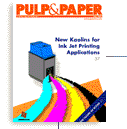
Process Control
At Donohue Forest Products, Saint-Felicien, Que., advanced digester controls, with a special liquor analyzer, provide measurable results
By Steve Pelletier, Roger Evans, and Torsten Wesslen
New Digester Controls at Donohue Boost Kraft Pulp Quality and Production
Donohue Forest Products Inc. in Saint-Felicien, Que., recently modernized continuous digester controls as part of an ongoing millwide automation project. The new digester controls include advanced control algorithms for chip and liquor movement throughout the digester, as well as dynamic cooking modeling for K number control.
Advanced supervisory digester controls were also installed for production rate scheduling, chip and liquor movement control, K number control, and washing control. In addition, state-of-the-art residual alkali control was employed, which utilizes an analyzer that automatically extracts liquor samples from various digester sampling points and uses fiber optics to carry the measurement to a central processing unit.
Benefits attributed to the implementation of advanced controls include increased throughput and improved product uniformity. Apart from benefits with incremental production, the improved product quality enhances the mill’s reputation for producing high-quality bleached softwood kraft pulp.
MILL BACKGROUND. The Saint-Felicien mill opened in 1978 with a design capacity of 700 mtpd for its continuous digester and pulp making operations. Since then, the mill has been able to increase production to 1,000 mtpd. This has been accomplished in part by installation of capital equipment, as well as improved operating practices.
The mill has integrated its pulp making operations with woodlands and sawmills. Wood furnish is comprised of high quality black spruce (80%) and balsam/jackpine (20%) fibers. The furnish is 100% chips, of which some 90% come from six Donohue sawmills. Two Price Waterhouse benchmark studies in 1997 and 1998 showed Saint-Felicien to be the lowest cost producer among 29 softwood kraft pulp mills in Canada, despite the mill’s relatively high chip costs.
The digester controls modernization is part of an ongoing millwide automation project to replace existing pneumatic and bench board controls with the Foxboro I/A distributed control system (DCS). Foxboro also supplied field instrumentation with digital integration with the DCS.
AUTOMATION PROJECT. Preliminary engineering for the automation project was done in 1994 and 1995, and this work encompassed the entire mill. The first part of the project covered the burner management system. The continuous digester was the latest project, to be followed by boiler operations, evaporators, bleaching, causticizing, and the pulp dryer. Walsh Automation was responsible for all aspects of the engineering and construction of the digester automation project.
In May 1998, old and primarily pneumatic controls in the digester area were replaced with a modern DCS. In October 1998, Foxboro provided its advanced supervisory control solution for the single vessel hydraulic continuous digester. The advanced control strategies were customized for the unique characteristics of the continuous digester, with input and recommendations from the mill.
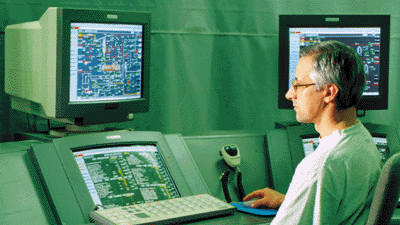
Donohue operator Claude Belletête monitors the mill’s continuous digester using the new DCS and supervisory controls.
Advanced control strategies. The digester controls at Saint-Felicien include advanced control algorithms for chip and liquor movement throughout the digester, as well as dynamic cooking modeling for K number control. All advanced digester control software was configured in the DCS control processor, which simplifies system maintenance, provides high reliability, and avoids the addition of any new external control equipment.
Advanced supervisory digester controls include production rate scheduling, chip and liquor movement control, K number control, and washing control, as well as state-of-the-art residual alkali control. Residual alkali controls utilize an in-line Fourier Transform Near Infra-Red alkali analyzer (FTNIR-analyzer) provided by Kvaerner-Chemetics.
The FTNIR-analyzer system was designed to automatically extract liquor samples from seven different digester sampling points, of which three measurements are currently used for residual alkali control. Fiber optics carry the residual alkali measurement from a simple flow-through cell to a central processing unit.
The primary objectives to justify a return on investment of the digester project included the following objectives:
- An increase in production of pulp by at least 1%
- Reduce K number (lignin removal) variability by 25%
CHIP AND LIQUOR MOVEMENT. From the chip bin to washing extraction in the digester bottom, the new advanced controls at Donohue carefully regulate digester activities and react to problems, such as hang-ups.
Chip bin level control. Significant effort was placed on controls pertaining to chip feed and chip level control in order to stabilize digester feed, chip column movement, and chip impregnation. The chip bin is used as a buffer between chip retrieval and the digester and also serves as the beginning of chip conditioning. Good chip bin level control is essential when pushing a continuous digester to extreme production limits with high demand for pulp quality and pulp uniformity.
The chip bin level controller manipulates the set point of the controller, adjusting the weight of chips to chip screening. The control is proportional only with a non-linear gain, so that an improved response would be given when the measured level is far from the set point.
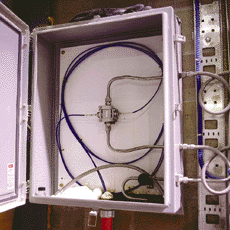
The liquor sample and flushing water flows through the field-mounted FTNIR alkali analyzer measurement cell in the vertical pipe. The horizontal fiber optic cables transmit the signal and the response to a central processing unit.
Chip meter speed is used as a feed forward signal. This speed is multiplied by a ratio of chip weight to rpm of the chip meter. This ratio is automatically updated at regular intervals. The chip weight control loop manipulates the speed of the two chip reclaims. Figure 1 shows the chip bin level control strategy.
Digester chip level control. As mentioned before with chip bin control, good digester chip level control is a must when a mill is striving to produce highly uniform pulp at maximum throughput. Digester chip level stability has improved significantly with the variable gain advanced controller that was employed by Donohue.
The chip level control in the digester is calculated from a conditioned and combined signal of three strain gauges located in the top of the digester at 1.33-m spacing. The level is controlled by manipulating the chip meter speed proportional to the error in the short term. This set point is constrained between configurable limits, normally plus or minus 0.3 rpm.
The blow to production ratio is manipulated in order to maintain the long-term digester chip level set point. The variable gain controller used automatically optimizes the proportional and integral action, depending upon the control error. Figure 2 shows the digester chip level control strategy.
Digester white liquor and residual alkali control. It is important to have a residual effective alkali concentration (NaOH + H Na2S) under control and as stable as possible in the cooking zone in order to maintain the most uniform and steady cooking conditions. At Donohue, the white liquor is introduced at three positions in the digester with the following approximate distributions:
- 80% with the chips
- 5% in the cooking circulation line
- 15% in the wash circulation line
The residual alkali set point in the upper heater is maintained by manipulating the active alkali-to-wood ratio. Upper and lower limits in this percentage active alkali-to-wood ratio are programmed to avoid any under or over dosage in the event of instrumentation problems.
There is approximately an hour delay between chip loading and white liquor in the upper digester and heating zone. In order to have faster control of the residual, an amount of white liquor is introduced in the cooking zone by the lower heating circulation.
The residual in the cooking zone is not measured, but calculated from the measured residual in the upper heating circulation and all the flows that converge into the zone. The residual set point in the cooking zone is maintained by manipulating the white liquor flow into this zone. The flow introduced at this location cannot exceed 10% of the total flow into the digester. Figure 3 shows the calculation of residual alkali in the cook zone.
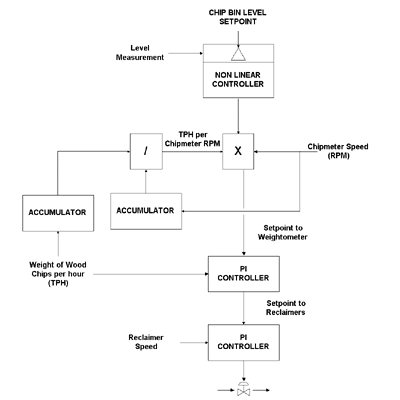
Figure 1: In the chip bin level strategy (shown) used by the new advanced controls, the chip weight control loop manipulates the speed of the two chip reclaims.
Washing extraction control in the digester bottom. Wash water coming from the diffuser washer and white liquor are introduced at different locations in the digester bottom. The flows must go counter current in the washing zone and are extracted by the extraction screens. The purpose of the upflow is to extend the cooking in the washing zone and to begin the brown stock washing.
The upflow is calculated by a total mass balance applied around the bottom of the digester. The set point of upflow is fixed by the operator and maintained by manipulating the extraction flow. In order to maintain pressure in the digester, the variations of extraction flow are immediately compensated for by a control loop, which manipulates the filtrate flow to the digester bottom.
Donohue's single vesset hydraulic continuous digester has a 1,000 mtpd capacity
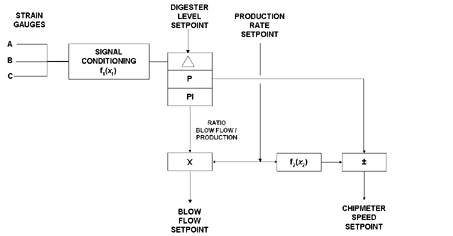
Figure 2: The variable gain controller automatically optimizes the proportional and integral action, depending upon the control error for digester chip level control strategy. Digester hang-ups. A “hang-up” is defined as a stop or slowing down of the chip column movement in the digester. This occurrence must be prevented as much as possible to avoid variations in retention time and other up-flow/down-flow disturbances. The conditions that typically prevail immediately prior to a hang-up condition are monitored by the control software:
- An excessive increase in the pressure differentials at the extraction screens, indicating compaction of chips across the screens
- A decrease in consistency of the blow line combined with a high chip level in the digester
- If either of these situations occurs, the extraction flow is automatically decreased to counteract a potential hang-up.
COOKING AND K NUMBER CONTROL. A control strategy utilizing a dynamic model that predicts the value of a controlled variable can be used when the measurement of this variable is not immediately available for feedback control. In a continuous digester, the K number can be predicted utilizing the effective alkali residual concentration in the cooking zone, the temperature, and the retention time.
This prediction is necessary for control, because samples of pulp used to measure the K number are taken in the blow line approximately two hours further down the process. However, other variables, which often cannot be measured, influence the K number as well—for example, seasonal changes in chip moisture and chip quality. For this reason the model automatically re-calibrates itself as often as possible.
Model re-calibration must not, however, take place during short term upsets. For example, if, over a short period, old chips are introduced into the digester, an effect will be observed on the K number that will be detected later during the blow line testing. The deviation between the prediction and the measurement would normally cause the model to be adjusted, which would in fact introduce a disturbance.
The model correction must therefore be done based upon disturbances that the system can control. The strategy chosen by Donohue is based on the following principles:
Kpred=C0 + K_correction + C1(HZCC - C2) + C3(HZLC - C4) + C5(Res - C6)
Where:
Kpred=Predicted K number
K_correction=Correction of the model following the comparison of predicted and measured values
HZCC=Target H-factor in the cooking zone
HZLC=Target H-factor in the washing zone
Res=Residual effective alkali calculated in the cooking zone
C0…C6=Constants or gains
H-factor versus cooking temperature. The H-factor referenced in the preceding section is obtained by multiplying the reaction coefficient and the cooking time. It is possible to obtain the reaction coefficient as follows:
R=H/tc
Where:
R=Reaction rate
tc=Cooking time
However, the reaction coefficient depends only on the temperature according to the following equation:
R=exp(43.2-16.113/T)
Where:
T=Temperature (Kelvin)
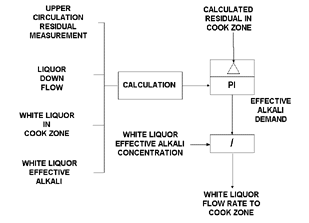
Figure 3: Residual alkali in the cooking zone is not measured, but calculated from measured residual in the upper heating circulation and all flows that converge into the zone.
RESULTS TO DATE. A statistical analysis was performed on production rate data from 12 months before the digester modernization project and after implementation to date. Since the implementation of the digester advanced control strategies, the average sustainable production rate has been well in excess of the expected 1% increase.
Analysis of K number variability indicates an 18% reduction in the K number variability to date. The mill is continuing with process analysis around the digester in order to further reduce the K number variability.
The system has been reliable and has exceeded expectations in many aspects. Operators are very comfortable using all the advanced supervisory control strategies. They have no hesitation pushing digester operations to the limit, while still maintaining very good stability of operation.
Steve Pelletier is process engineer at Donohue Forest Products, Saint-Felicien, Que. Roger Evans is marketing manager for Foxboro in Montreal, Que., and Torsten Wesslen is an application consultant for Foxboro in Atlanta, Ga.

|

